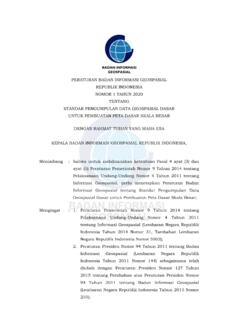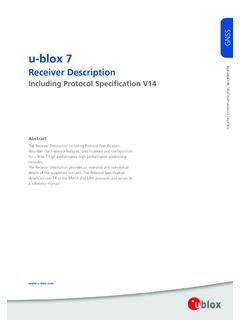Transcription of Navigation: Use of Electronic Navigation Aids - GOV.UK
1 MARINE GUIDANCE NOTE MGN 379 (M+F) Navigation : Use of Electronic Navigation Aids Notice to all Owners, Masters, Skippers, Officers and Crews of Merchant Shipsand Fishing Vessels This notice replaces MGN 63 PLEASE NOTE:-Where this document provides guidance on the law it should not be regarded as definitive. The way the law applies to any particular case can vary according to circumstances - for example, from vessel to vessel and you should consider seeking independent legal advice if you are unsure of your own legal position. Summary This note emphasises the need for correct use of navigational equipment by watch-keepers. Key Points:- Be aware that each item of equipment is an aid to Navigation . Be aware of the factors which affect the accuracy of position fixing systems. Appreciate the need to cross check position fixing information using other methods. Recognise the importance of the correct use of navigational aids and knowledge of their limitations.
2 Be aware of the dangers of over-reliance on the output from, and accuracy of, a single navigational aid. 1. INTRODUCTION Accidents have occurred where the primary cause has been over-reliance on a single Electronic navigational aid. Watch-keepers must always ensure that positional information is regularly cross-checked using other equipment, as well as visual aids to Navigation . In other cases accidents have occurred where the watch-keeper was not fully conversant with the operation of equipment or its limitations. 2. PROVISION OF NAVIGATIONAL EQUIPMENT ON SHIPS The Merchant Shipping (Safety of Navigation ) Regulations 2002 (SI 2002 No 1473) implement the carriage requirements for navigational equipment set out in Regulation 19 of Safety of Life at Sea (SOLAS) Chapter V. These requirements, together with guidance notes, are contained -1 -in the 2007 Edition of the Maritime and Coastguard Agency (MCA) publication Safety of Navigation Implementing SOLAS Chapter V 2002 Ships built before 1 July 2002 may continue to comply with the requirements of SOLAS Chapter V/74 in force prior to 2002 Regulations, with regard to Signalling Lamps (Reg.)
3 11/74), Navigation Equipment (Reg. 12/74) and Nautical Publications (Reg. 20/74). However they must carry a global Navigation satellite system ( gnss ) receiver or a terrestrial radio- Navigation receiver, Automatic Identification system (AIS) and Voyage Data Recorder (VDR) or Simplified Voyage Data Recorder (S-VDR) in accordance with the timetables set out in Regulations 19 and 20 of SOLAS V 2002. Guidance is also given in Annex 20 of the MCA Safety of Navigation publication on siting and servicing of the installations. 3. RADAR AND PLOTTING AIDS General Collisions have been frequently caused by failure to make proper use of radar and radar plotting aids in both restricted visibility and clear weather. Common errors have been deciding to alter course on the basis of insufficient information and maintaining too high a speed, particularly when a close-quarters situation is developing.
4 Information provided by radar and radar plotting aids in clear weather conditions can assist the watch-keeper in maintaining a proper lookout in areas of high traffic density. It is most important to remember that Navigation in restricted visibility can be more demanding and great care is needed even with all the information available from the radar and radar plotting aids. Where continuous radar watch-keeping and plotting cannot be maintained even greater caution must be exercised. A safe speed should at all times reflect the prevailing circumstances. Electronic radar plotting aidsRadars must be equipped with plotting aids, the type of which depends upon the size of ship as follows; a) Electronic Plotting Aid (EPA)EPA equipment enables Electronic plotting of at least 10 targets, but without automatic tracking (Ships between 300 and 500 Gross Tonnage (GT)).
5 B) Automatic Tracking Aid (ATA)ATA equipment enables manual acquisition and automatic tracking and display of at least 10 targets (Ships over 500 GT). On ships of 3000 GT and over the second radar must also be equipped with an ATA, the two ATAs must be functionally independent of each other. c) Automatic Radar Plotting Aid (ARPA)ARPA equipment provides for manual or automatic acquisition of targets and the automatic tracking and display of all relevant target information for at least 20 targets for anti-collision decision making. It also enables trial manoeuvre to be executed (Ships of 10000 GT and over). The second radar must incorporate ATA if not ARPA. Manual plotting equipment is no longer acceptable except for existing vessels still complying with SOLAS V/74. Watch-keepers must be fully conversant with the operation and limitations of these plotting facilities and should practice using them in clear-weather conditions to improve their skills.
6 In addition to the advice given above and the instructions contained in the Operating Manual(s), users of radar plotting aids should ensure that: (i) performance of the radar is monitored and optimised (ii) test programmes provided are used to check the validity of the plotting data, and - 2-(iii) speed and heading inputs to the ARPA/ATA are satisfactory. Correct speed input, where provided by manual setting of the appropriate ARPA/ATA controls or by an external input, is vital for correct processing of ARPA/ATA data. Serious errors in output data can arise if heading and/or speed inputs to the ARPA/ATA are incorrect. For full details of the carriage requirements and associated guidance see Regulation 19 and Annex 16 of the MCA Safety of Navigation publication. PlottingTo estimate risk of collision with another vessel the closest point of approach (CPA) must be established.
7 Choice of appropriate avoiding action is facilitated by the knowledge of the other vessel s track using the manual or automatic plotting methods (see above). The accuracy of the plot, however obtained, depends upon accurate measurement of own ship s track during the plotting interval. It is important to note that an inaccurate compass heading or speed input will reduce the accuracy of true vectors when using ARPA or ATA. This is particularly important with targets on near-reciprocal courses where a slight error in own-ship s data may lead to a dangerous interpretation of the target vessel s true track. The apparent precision of digital read-outs should be treated with caution. If two radars are fitted (mandatory for ships of 3000 GT and over) it is good practice, especially in restricted visibility or in congested waters, for one to be designated for anti-collision work, while the other is used to assist Navigation .
8 If only one of the radars is fitted with ARPA then this should be the one used for anti-collision work and the other for Navigation . InterpretationIt is essential for the operator to be aware of the radar s current performance which is best ascertained by the Performance Monitor. The echo return from a distant known target should also be checked. Be aware of the possibility that small vessels, ice floes or other floating objects such as containers may not be detected. Echoes may be obscured by sea- or rain-clutter. Correct setting of clutter controls will help but may not completely remove this possibility. When plotting larger targets on a medium range scale, the display should be periodically switched to a shorter range, and the clutter controls adjusted, to search for less distinct targets. The observer must be aware of the arcs of blind and shadow sectors on the display caused by masts and other on-board obstructions.
9 These sectors must be plotted on a diagram placed near the radar display. This diagram must be updated following any changes which affect the sectors. Choice of range scaleAlthough the choice of range scales for observation and plotting is dependent upon several factors such as traffic density, speed of own ship and the frequency of observation, it is not generally advisable to commence plotting on a short range scale. Advance warning of the approach of other vessels, changes in traffic density, or proximity of the coastline, should be obtained by occasional use of longer range scales. This applies particularly when approaching areas where high traffic density is likely, when information obtained from the use of longer range scales may be an important factor in determining a safe speed. AppreciationA single observation of the range and bearing of an echo will give no indication of the track of a vessel in relation to own ship.
10 To estimate this, a succession of observations must be made over a known time interval. The longer the period of observation, the more accurate the result will be. This also applies to ARPA/ATA which requires adequate time to produce accurate information suitable for assessing CPA / TCPA and determining appropriate manoeuvres. Estimation of the target s true track is only valid up to the time of the last observation and the situation must be kept constantly under review. The other vessel, which may not be keeping a radar watch or plotting, may subsequently alter its course and/or speed. This will take time to - 3-become apparent to the observer. Electronic plotting will not detect any alteration of a target s course or speed immediately and therefore should also be monitored constantly. The compass bearing, either visual or radar should be used to assess risk of collision.











